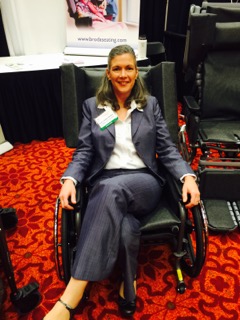Category: McKnight’s Long-Term Care News
Posted by Dr. El - January 6, 2016 - Business Strategies, Communication, For Staff, McKnight's Long-Term Care News, Motivating staff, Psychology Research Translated, Something Good About Nursing Homes

Here’s my latest article on McKnight’s Long-Term Care News:

Woohoo! My first column of 2016.
Which was started during a bout of insomnia in the last week of 2015.
What did I do when sleep failed me? What electronics-addicted individuals often do in the middle of the night. I grabbed my computer, caught up on email, and headed over to Facebook to find out what my Friends had been up to.
There I discovered a post about a company founded by two brothers called Life is Good, which emerged from the standing request the founders’ mother had for them as children in a chaotic home environment: Tell me something good about your day.
This helped the brothers become “glass half full” kind of guys, the type of people who donate 10% of their profits to help children overcome adverse childhood experiences.
And what does a T-shirt company have to do with long-term care? Well…
What if we started off this brand new year asking ourselves and our coworkers, employees and residents to tell us something good?
What if we put time and thought into focusing on the positive — into growing the good — and reminding ourselves why we’re all here working with elders?
I predict we’ll have more productive staff, better functioning teams, and happier residents.
It’s not just me doing the predicting. The Positive Psychology Center, led by director Martin Seligman, Ph.D., describes positive psychology as “the scientific study of the strengths that enable individuals and communities to thrive.”
For the entire article, visit:

Posted by Dr. El - December 23, 2015 - For Fun, McKnight's Long-Term Care News, Something Good About Nursing Homes

Here’s my latest article on McKnight’s Long-Term Care News:

There are many givers in senior care facilities. Sometimes they don’t even realize it themselves. This holiday season is a good time to recognize them — and the things that make smiles bright.
The Twelve Days of Christmas in LTC
On the first day of Christmas, my residents gave to me a thank you for my good care.
On the second day of Christmas, my residents gave to me two knitted mittens and a thank you for my good care.
On the third day of Christmas, my residents gave to me three candy canes, two knitted mittens and a thank you for my good care.
On the fourth day of Christmas, my residents gave to me four graham crackers, three candy canes, two knitted mittens and a thank you for my good care.
On the fifth day of Christmas, my residents gave to me five beaming smiles, four graham crackers, three candy canes, two knitted mittens and a thank you for my good care.
On the sixth day of Christmas, my residents gave to me six warm handshakes, five beaming smiles, four graham crackers, three candy canes, two knitted mittens and a thank you for my good care.
For the entire article, visit:

Posted by Dr. El - December 8, 2015 - Business Strategies, McKnight's Long-Term Care News, Motivating staff

Here’s my latest article on McKnight’s Long-Term Care News:

After a staff training on reducing burnout in long-term care last week, a look through the evaluation forms was illuminating. A significant number of attendees — mostly nursing aides, nurses, and environmental workers — wrote that the most valuable point they got from the training was how important it was to take time for themselves, even if it was for just a few minutes.
Apparently the 10-minute meditation we practiced using an app on my smartphone made a big impression on them. What struck me was how novel that experience was for them.
With frequent callouts and turnover rates troublingly high (50% for nurses and 51.5% for aides, according to a 2012 AHCA report), working short-staffed seems to be the rule rather than the exception. It means workers are being stretched ever thinner and being pulled in many directions by the needs of their residents.
With the holidays upon us, staff members have extra duties at home — gifts to purchase, parties to plan and attend, and special foods to cook.
By this time in December, your workers are probably maxed out.
This is a great opportunity to show that you’re thinking of them and that you recognize how stressful the holidays can be. It’s also a good way to prevent the staff burnout that leads to callouts, resignations and injuries.
For the entire article, visit:

Posted by Dr. El - November 12, 2015 - Business Strategies, Customer service, Dementia, End of life, McKnight's Long-Term Care News, Medication issues, Motivating staff, Resident care

Here’s my latest article on McKnight’s Long-Term Care News:

Despite the diversity of the events I attended during my brief visit to the LeadingAge convention in Boston last week, a theme clearly emerged. The thread that ran through the varied offerings was well-being.
Retaining staff
In researcher and consultant Joanne L. Smikle, PhD’s talk on staff retention, rather than focusing on why employees are leaving, she looked instead at why they stay.
Based on her studies of long-term care organizations, she found that “if the leadership of the organization lacks passion, you will have trouble with retention and commitment.”
In healthy organizations, staff members “from the top of the house to the bottom of the house” stay because they can say, “I felt I mattered.” Experiences that contribute to that feeling: Recognizing staff in formal and informal ways, an open dialogue with staff rather than top-down communication, and a focus on the human elements enabling employees to make connections with each other, the residents and the families.
Dementia care
G. Allen Power, MD, FACP titled his presentation, “Enhancing well-being for people living with dementia,” so it wasn’t surprising that this was a central point in his talk.
He asserted that antipsychotics don’t work and don’t treat the true causes of the behaviors associated with dementia. Instead, he recommends focusing on the seven primary domains of well-being, which are part of the Eden Alternative model of care: identity, growth, autonomy, security, connectedness, meaning and joy.
In one instance, a resident who became agitated when he was prevented from leaving the building was allowed outside. The man looked at the cows in a nearby field and returned to spend the rest of the day calmly. The team, who subsequently learned that the resident had been a farmer whose daily routine included an early morning check on his animals, had given him not only autonomy, but had also affirmed his identity and added meaning and joy to his life. His agitation disappeared.
Keynote address
Atul Gawande, MD delivered a Monday morning keynote address. Author of the book “Being Mortal,” Dr. Gawande discussed ways in which to improve end of life treatment. He advocated for care that takes into account the desires of the patient and noted that there is more to living than extending the amount of time we live.
For the entire article, visit:

Leonard Florence ALS unit entrance
Posted by Dr. El - October 27, 2015 - Business Strategies, McKnight's Long-Term Care News, Motivating staff

Here’s my latest article on McKnight’s Long-Term Care News:

During the Q&A section of my McKnight’s Fall Expo webinar “Letting them go with style,” the conversation turned toward why staff members are leaving their long-term care positions.
As I pointed out then, workers often give plausible but incomplete reasons for leaving their positions because they plan to work elsewhere in the industry and don’t want to burn any bridges. Others exit without giving notice. Without knowing the real reasons why employees leave, it’s difficult to make adjustments that will lessen turnover.
Challenging assumptions
Organizations sometimes disparage the departing employee rather than look at what might have contributed to their resignation. Psychologically speaking, this lessens the “narcissistic injury” of someone leaving. A narcissistic injury is one that hurts our sense of self. Rather than feel the pain of being rejected, we reject them.
A typical assumption is that there was something wrong with the resigning worker. For example, they weren’t dedicated enough, they didn’t appreciate the benefits of the organization, or they weren’t very good anyway (the “sour grapes” effect). This leads to the sweeping conclusion that you just can’t find good people these days.
Rejecting someone who has left us may help us get over failed romantic relationships, but it’s a missed opportunity in business, especially if our workers keep marching out the door in droves as they have a tendency to do in LTC.
For the entire article, visit:

Posted by Dr. El - October 14, 2015 - Anecdotes, For Fun, McKnight's Long-Term Care News, Personal Reflections, Role of psychologists

Here’s my latest article on McKnight’s Long-Term Care News:

“The Adventures of
The Geropsychologist!”
Starring Dr. El as
The Geropsychologist!
There have been thousands of movies and TV shows about the exciting work of cops, lawyers, and hospitals, but long-term care? Fuhgeddaboutit!
Here, Dr. El aims to correct that oversight with a show that reveals the versatility and pragmatism of a nursing home psychologist willing to do what it takes to meet the needs of her residents.
Act 1, Scene 1
In today’s episode, Dr. El walks into 85-year old resident Frank Corolla’s nursing home room. His bed is neatly made and the curtain is drawn between his bed and his neighbor’s in their semi-private room. Mr. Corolla is sitting in his chair in his pajamas and bathrobe, listening to the radio.
Dr. El (in a loud voice): Hey, Mr. Corolla! It’s Dr. El. How are you doing today?
Mr. Corolla (looking sad): Not good.
Dr. El (sitting on the edge of the bed): What’s the matter?
Mr. Corolla: My eyes are hurting me so bad I was crying today.
Dr. El: Did that help?
Mr. Corolla: No.
Dr. El: I’m sorry to hear that. I’ll talk to the nurse. I’ll be right back.
Act 1, Scene 2
Dr. El appears at the nursing station and waits while the nurse finishes her phone call. The nurse hangs up.
Nurse: How are you, Dr. El? How can I help you?
Dr. El: Well, I’m good, thanks, but Mr. Corolla eyes are hurting him so badly he was crying today. I wrote a note for the doctor last week but I don’t see any follow up. Do you know what’s happening with that?
Nurse (looking in the computer): I don’t see anything from the doctor. I’ll call the nurse practitioner.
Dr. El: Thanks!
Act 1, Scene 3
Dr. El runs into the nurse in the stairwell.
Dr. El: Were you able to reach the nurse practitioner?
Nurse: Yes. She put in an order to see the ophthalmologist.
Dr. El: Awesome!
[Canned applause]
Act 2, Scene 1
Dr. El walks into Ms. Johnson’s room and finds her frantically rummaging through her closet with one hand. With the other, she holds on to the wall. She looks like she’s about to fall.
Dr. El: Ms. Johnson! Are you OK? What are you doing?
Ms. Johnson (looking up with tears in her eyes): I was looking for a shirt I wanted to wear and look how they do my things! All crammed in here like they was nothing! They’s something to me. They’s all I got.
For the entire article, visit:

Posted by Dr. El - September 30, 2015 - Business Strategies, Common Nursing Home Problems and How Psychologists Can Solve Them, Communication, McKnight's Long-Term Care News, Medication issues, Motivating staff, Psychology Research Translated, Role of psychologists, Something Good About Nursing Homes

Here’s my latest article on McKnight’s Long-Term Care News:

Antipsychotic medications have proved ineffective at reducing the symptoms associated with dementia. They also have serious side effects in older adults, including restlessness, dizziness, higher likelihood of falls and other problems that can contribute to an increased risk of death.
Behavioral health interventions, on the other hand, have no such side effects and have been found effective in reducing behaviors such as aggression, care refusal and wandering.
Employing behavioral health techniques with people with dementia becomes increasingly valuable as facilities in this country endeavor to follow the Centers for Medicare & Medicaid Services guidelines and reduce the use of antipsychotic medications.
Global efforts
Dementia care is a pressing issue around the world, and other countries have made headway in shifting from medication to behavioral interventions. Psychologist Paula E. Hartman-Stein, Ph.D., of The Center for Healthy Aging, writes about international programs that implement behavioral health methods in the September/October edition of The National Psychologist.
Dr. Hartman-Stein spoke with Cameron Camp, Ph.D., an expert who consults with long-term care facilities in the United States and abroad.
France
Dr. Camp reports that the French government pays nursing homes to train their staff in non-pharmacological approaches to dementia. The training includes various strategies, including Montessori techniques such as those described by Dr. Camp in his excellent book, “Hiding the Stranger in the Mirror,” and other publications.
Australia
Camp notes that Alzheimer’s Australia provides funding to train staff in behavioral health approaches. Its website, Alzheimer’s Australia Information for Health Professionals, offers helpful information and brief videos that explain the techniques used.
Canada
In Canada, the Canadian Foundation for Healthcare Improvement reports on the success “beyond the team’s expectations” of an effort to reduce antipsychotic medications and implement non-pharmacological approaches. The project saved $400,000 in six months across the Winnipeg region.
STAR-VA in the USA
Here in the United States, the Veterans Health Administration, less constrained by the fee-for-service psychotherapy model that plagues the rest of the country, utilizes staff psychologists and other behavioral health professionals in their Staff Training in Assisted Living Residences (STAR-VA) model.
For the entire article, visit:

Posted by Dr. El - September 15, 2015 - Business Strategies, Communication, Customer service, Engaging with families, McKnight's Long-Term Care News, Resident/Family councils

Here’s my latest article on McKnight’s Long-Term Care News:

When families seek mental health treatment, it’s often because of a “problem child.” Family therapists consider this person to be the “identified patient” and recognize that the troubled individual is part of a family unit whose members all benefit from assistance.
By contrast, when a resident enters long-term care, we tend to focus solely on the needs of the resident, even though they’re almost always part of a family system that is being affected by their placement.
Oddly, we do this in spite of the fact that it’s frequently a family member who chooses the facility or community where the loved one will live.
If we consider that we’re admitting families rather than just the residents themselves, we’d recognize the need to provide family-centered care in addition to resident-centered care.
Instead, we repeatedly attend to the needs of families in a haphazard, reactive fashion. Those tense family meetings with the director of nursing and the administrator after the staff “mishandled” an interaction with a family member are more likely a lack of organizational attention to the needs of families and an absence of proper training than they are a reflection of staff error or of a “difficult” family.
Here are some ways to implement family-centered care:
1. Convey essential information to families about your facility or campus in a way that’s easy to access. If your website offers only platitudes about how you really care and then lists insurance options, you’re telling potential customers what you really care about and it isn’t them. Instead, turn your site into a 24/7 support kiosk, answering questions families commonly have about your community and helping them to be better caregivers and community members. Include, for example, information about their role in care plan meetings or how to help their loved one adjust to their new home. Add a list of resources they might want to consult. (My book, “The Savvy Resident’s Guide,” for example, is one way to offer information and soothe the frayed nerves of family members.)
2. Hold regular family meetings on topics that frequently affect them, such as caregiver stress, understanding dementia, and making the most of an off-campus pass (a great session to hold before the holiday season, hint, hint). Even though this may seem like yet another task to add to an already burdened staff, it will save time in the long run: Rather than answer the same questions individually, your staff can direct families to the meetings where questions can be discussed simultaneously and in depth.
3. Reach out to families during transitions in care, such as moving from an independent apartment to the care center in a continuing care retirement community.
For the entire article, visit:

Posted by Dr. El - September 10, 2015 - Communication, McKnight's Long-Term Care News, Talks/Radio shows

Over 1000 listeners attended my McKnight’s Fall Online Expo webinar, “Letting them go with style,” which focused on ways to use the loss of employees to strengthen your organization. McKnight’s editor Jim Berklan moderated the event and shared his thoughts about the webinar in his Daily Editor’s Notes column today. I’m gratified to hear that the talk helped participants consider aspects of staff departures in a way they hadn’t previously considered. (Thank you, Jim, for your kind review!)
You can hear the replay of the webinar (archived for a year) at: Expo Registration
It’s fairly likely that one or more of your employees will be leaving soon. That’s why you need to read this. It will make your organization healthier, and in ways you might have never imagined.
The goodbye guru would have it no other way.
I typed that name generically — with lowercase g’s — but I just as easily could have written Goodbye Guru. Then I would be referring to a specific person, namely Eleanor Feldman Barbera, Ph.D.
You might know her better as “Dr. El,” as in “The World According to Dr. El,” the award-winning blog that appears twice monthly on this website.
Regardless, she is an eloquent font of knowledge about what makes humans tick, and tock. Wednesday, we had a unique opportunity to hear her address a slightly off-kilter question: How should providers deal with an employee’s departure to create the best circumstances for their long-term care community?
I say “off-kilter” because the most common inference about a webinar named “Letting them go with style” would be that it’s about dying residents. Instead, Barbera fascinated listeners at McKnight’s Fall Online Expo with approaches and implications for dealing with departing employees.
Whether by firing, lay-off, resignation or for other reasons, employees leave long-term care operators often. And the emotional and psychological well-being of whoever remains is typically the worse for it — and usually to an unnecessary degree — Barbera pointed out.
It doesn’t have to be that way. She urged everyone to consider the multiple layers of messages any departure makes. This could mean saddened and suddenly insecure residents (“Who will take care of me?” “Didn’t she like me enough to say goodbye?”) to unnerved or perturbed staff members, to disgruntled or dangerous former employees.
All of which make for an unstable environment. Thus, more care should be taken with departing employees, Barbera emphasized. She illustrated numerous scenarios involving employee terminations, pointing out how providers can handle them better.
For the rest of Jim Berklan’s article, visit:

Posted by Dr. El - September 3, 2015 - Business Strategies, Communication, McKnight's Long-Term Care News, Talks/Radio shows

It’s time for McKnight’s Fall Online Expo!
I’m pleased to be presenting at 11am ET on Wednesday, September 9th on the topic of “Letting Them Go with Style.” This free hour-long webinar will focus on how to use the loss of employees to strengthen your organization.
The other two webinars will address reimbursement and technology. The Expo will also offer the opportunity to earn CE credits, visit with vendors and chat with colleagues. It’s a great way to attend a conference without leaving your desk. I highly recommend it.
For more information and to register, visit McKnight’s Fall Expo.
Hope to see you there!





















